How to clean the toilet with a bottle: step-by-step installation + an overview of alternative methods
Any home should have a means of cleaning the sewer. Clogs in the toilets do not appear on schedule, but in those moments when no one expects problems and there is no time for shopping.
In such cases, you can do it with improvised means, and an ordinary plastic bottle will help save the situation. We will tell you how to clean the toilet with a bottle. We will describe in detail what else can be used to quickly fix problems in the work of plumbing.
The content of the article:
The causes of blockages in the toilet
A clogged toilet is one of the biggest annoyances that can only happen to sewers. If the water drain stops, sewage fills the bowl of the sanitary ware, and a heavy smell is carried around the house.
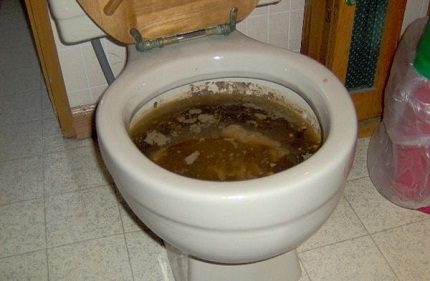
Although the first and most important is cleaning, it’s advisable to figure out what exactly caused the stagnation of water in order to know how to handle the sanitary equipment in the future.
There are two main reasons why blockage may occur: improper installation and neglect of the toilet. The operation of the toilet may be impaired if it is connected to the riser by a pipe too large. There is not enough slope for the normal discharge of wastewater, and deposits remain on the pipe walls.
The clearance in the pipes gradually narrows, so sooner or later there comes a moment when it becomes insufficient for the passage of water. A cardinal way to solve problems associated with poor-quality installation of the device is proper installation.

With regard to operation, it is important to remember: the toilet is a useful plumbing equipment, and not a garbage can into which garbage can be dumped.The device is not intended for pouring out cat litter fillers, throwing cotton wool, rags, diapers, threads, food waste, construction debris and cement mortar residues.
If you handle the toilet like a trash, it will inevitably result in blockages. You can not throw anything superfluous into it. Accidentally dropped objects should be immediately taken out of the toilet bowl, and not ignored, let alone rinse, pushing further into the sewer pipe.
General principles of sewage
The sewer system consists of a riser and pipelines that are designed to drain liquid effluents from plumbing fixtures. The riser is a pipe of large diameter and is usually located in the bathroom.
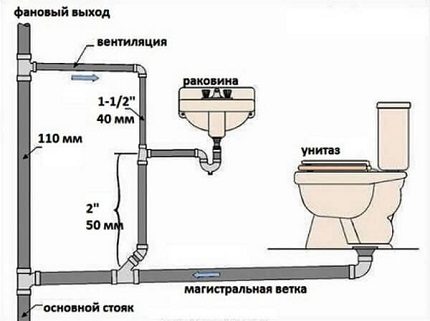
Modern risers are often made of plastic, but many houses still have cast-iron pipes. The advantage of cast iron is durability, and plastic risers are less prone to clogging. Most often, old cast-iron pipes are clogged. There are burrs on their inner walls, which is why deposits form quickly.
To prevent air from entering the sewage system, a siphon is provided in the toilet design - a bend, where the water plug (water lock) is constantly located. When draining, water displaces and replaces this plug, pushing sewage from the toilet into the sewer riser.
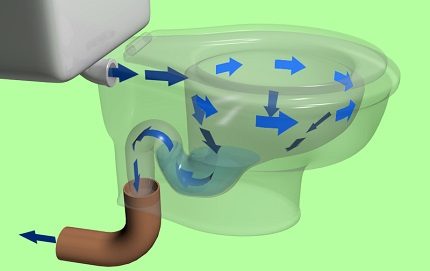
If there is debris in the pipe and the water does not squeeze it into the riser, clogging may occur. For sharp or large objects, pieces of paper, waste, hair, threads are caught. Gradually, all this turns into a large lump of dirt, which narrows or completely covers the pipe section.
Plastic bottle clogging
If there are no sewer cleaning equipment, the situation can be saved using a regular plastic bottle of 1.5-2 liters. Of the tools you need only a sharp knife.
The sequence of manufacture of the device for cleaning the toilet:
- Screw the cap tightly onto the neck of the bottle.
- Use a felt-tip pen or marker to draw a line at the bottom of the bottle above the bottom.
- With a sharp knife or large scissors, carefully cut the bottom. Make sure that the cut line is flat, without any special protrusions and depressions.
To clean the toilet, insert the bottle into the drain hole with the cut-off part and sharply, with force, push the water up and down. Then flush the toilet with hot water. Watch the temperature of the water: it should be hot, but not scorching. Otherwise, the plumbing may simply burst.
By the principle of operation, a homemade cleaning device from a bottle resembles a plunger. Water practically does not compress, its volume remains unchanged. By pushing water into the toilet with a bottle, you can create a water hammer effect and thus destroy the blockage.
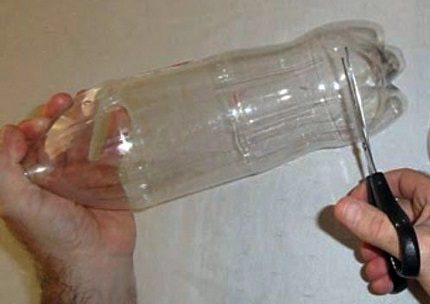
When cleaning the toilet with any tools, including and self-made, there is always a risk of damaging the plumbing or getting unpleasant "side effects":
- Too strong reciprocating movements can ensure that water does not flood into the pipe, as expected, but out. In this case, the fountain from the toilet may hit the ceiling.
- With careless movement, you can hit the toilet bowl or drop a hard heavy object on top of it. This threatens the appearance of cracks and chips on the device, especially if it is made of fragile faience.
Such phenomena are not frequent, but they do happen, so care should be taken. The risk of “water hammer in the opposite direction” exists if the toilet is clogged with solid objects: glass fragments, construction debris, cement.

If scraps of paper, cotton wool, rags or other soft objects got into the toilet, then a plastic bottle is quite capable of pushing them into the sewer without any problems. Also with its help you can get them out of the toilet. To do this, you need to build a homemade plastic cable.
Some useful tips:
Plastic bottle rope
To make a plumbing cable you will need a large 5-liter plastic bottle. If there is only a 2-liter, it will also work, but the product will be shorter. Of the tools you will need large, durable scissors.
Work order:
- First you need to mark up. An ordinary pencil does not draw on plastic, so it is better to take a marker or a children's felt-tip pen. It is necessary to apply a spiral strip 2 cm wide along the entire length of the bottle.
- In the manufacture of bottles, manufacturers use thicker plastic at the bottom of the products. The material bends worse, but much stronger than in the upper part. It is perfect for a pen that looks like a ring. Draw this detail right away.
- Cut the bottle according to the marking. You should get a long spiral tape with a round element on the end.
- Cut a hole in the middle of the “ring” so that your finger can freely pass into it.
- Over the entire length of the tape, make a notch: cut it on both sides at an angle of 45 degrees. Make sure that the notches are not too deep and the cable retains its strength.
To remove or slide objects stuck in the toilet, insert a homemade cable into the drain hole, holding the handle. Try to push the product as far as possible and gently scroll around its axis. When the cable reaches the clog, rotational movements will help pick up trash for serifs.
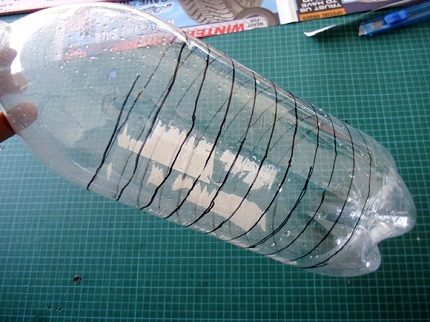
Try to remove stuck items. If this does not work out, just push them into the pipe.
A sign that everything turned out right is the decrease in the number of drains in the toilet. As soon as sewage starts to drain, flush the appliance with hot water.
Methods for cleaning the toilet with a conventional plumbing cable are given in this article. We recommend that you read the instructions for use.
Cleaning the toilet with a rag
In the absence of a plunger, even the most ordinary sex rag can become a powerful weapon in the fight against toilet blockages. In addition to it, you will need a wooden block the thickness of a mop handle. You can use the mop itself, but this is not always convenient because of the long length.
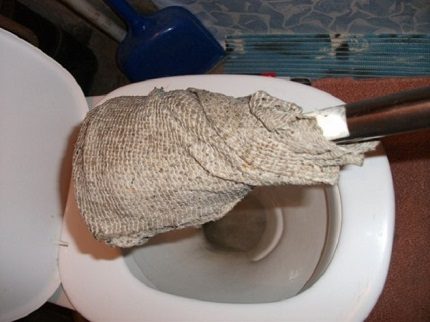
The wet rag should be folded and plugged into the toilet drain hole.It will turn out a dense makeshift cork. In its center you need to attach a mop or bar and several times press strongly, as on the plunger handle. A sharp movement causes water hammer and destroys the cork.
Unique chinese method
Chinese and Korean industry produces a special film for cleaning the toilet. If you can meet her on sale, be sure to buy and store. In the case of blockages, the film can be a real salvation, because eliminates them in a few moments.
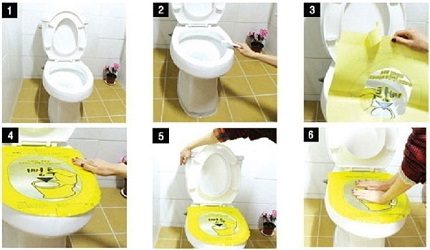
The principle of cleaning the toilet with a film is simple to genius, but it looks rather strange, because first you have to increase (and not reduce) the blockage. This is done as follows: throw crumpled toilet paper into the standing water of the bowl and empty the tank so that the toilet bowl is almost filled to the brim.
The rim of the toilet bowl is wiped dry and a special high-strength film is glued. It should fit snugly over the rim over the entire adhesive surface so that not even the slightest gaps or air bubbles remain.
The places where the film adheres to the toilet bowl are gently smoothed. After that, several times they lower the water from the tank so that the film inflates, and push the bubble down in smooth wavy movements.
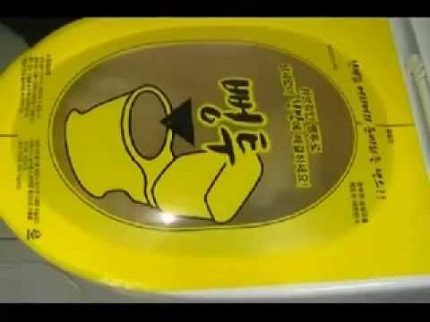
Some especially bold "folk craftsmen" advise using food instead of a special film. They offer hermetically close the toilet, draw water and press the same way from above.
This method is in great doubt, because the adherence of the food film is in question. In addition, it is not strong enough, so it can not withstand pressure and burst. In this case, the entire bathroom will be flooded with the contents of the toilet bowl, and the blockage will still not go anywhere. Better not take the risk.
Other ways to eliminate blockages
The modern market for plumbing fixtures is diverse: you can find any tools for mechanical cleaning of sewers. Some of them are very compact and easy to use. The classics of the genre are cable and plunger.
A metal cable can not always be used, because there is a risk of damage to the plastic elements of the sewer system. But a rubber or silicone plunger is an indispensable thing in the household.
An alternative to mechanical methods is household chemicals. Packaging a good specialized cleaner and sewage flushing will cost less than any plumbing fixture and take up very little space.

Household chemicals not only corrode plugs. It removes the plaque from the inner surfaces of the pipes, due to which the lumen narrows and blockages form. An additional plus is disinfection, which is never superfluous in the toilet.
In addition to preventing the formation of traffic jams in the most popular form, plumbing will not be out of place means for cleaning sewer pipes. Their gradual clogging and narrowing of the lumen also contribute to clogging the toilet.
Conclusions and useful video on the topic
You can choose any of the methods you like to eliminate blockage in the toilet. We offer videos that will help you understand the work of the plumbing fixture and fix the problem.
Video, thanks to which you can understand how the toilet flush system works:
Detailed video instructions for using a plastic bottle to clean the toilet:
Chinese method of dealing with blockage in the toilet using a special adhesive film:
There are many ways to eliminate blockages in the toilet, including very original. However, it is better not to reinvent the wheel, but to buy an ordinary plunger.
It must be washed, dried after use and stored in a secluded corner of the bathroom, then it will last for many years. If you didn’t take care of buying a plunger in time, and the toilet needs to be cleaned urgently, a bottle will help you.
Want to tell how you coped with punching a mash in the toilet using improvised tools? Is there an interesting way to deal with traffic jams in your arsenal? Please write comments in the block below, ask questions, comment on the material, post a photo on the topic.

 How to clean a blockage in the toilet: a comparison of the best methods and equipment
How to clean a blockage in the toilet: a comparison of the best methods and equipment 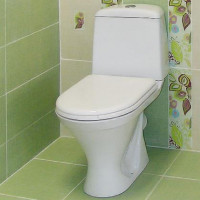 How to install a toilet on a tile: an overview of the best ways and technical nuances
How to install a toilet on a tile: an overview of the best ways and technical nuances 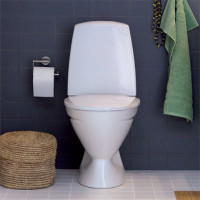 How to fix the toilet to the floor: an overview of the technical details and the best installation methods
How to fix the toilet to the floor: an overview of the technical details and the best installation methods 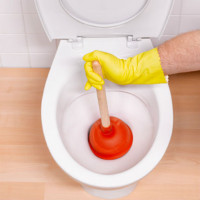 How to clean your toilet yourself: the best ways to eliminate blockages
How to clean your toilet yourself: the best ways to eliminate blockages 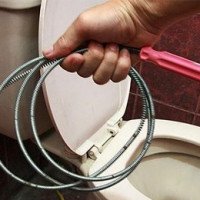 How to clean the toilet bowl with a cable: choosing a tool and instructing on its use
How to clean the toilet bowl with a cable: choosing a tool and instructing on its use 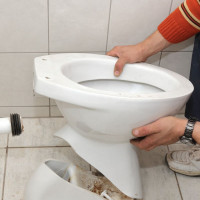 How to replace the toilet: step-by-step instruction on how to replace the toilet with your own hands
How to replace the toilet: step-by-step instruction on how to replace the toilet with your own hands  How much does it cost to connect gas to a private house: the price of organizing gas supply
How much does it cost to connect gas to a private house: the price of organizing gas supply  The best washing machines with dryer: model rating and customer tips
The best washing machines with dryer: model rating and customer tips  What is the color temperature of light and the nuances of choosing the temperature of the lamps to suit your needs
What is the color temperature of light and the nuances of choosing the temperature of the lamps to suit your needs  Replacement of a geyser in an apartment: replacement paperwork + basic norms and requirements
Replacement of a geyser in an apartment: replacement paperwork + basic norms and requirements
Now there are a lot of good household chemicals, which helps to keep all the plumbing in the house clean. And if the installation is done correctly, then you need to be very lazy to prevent blockages. It’s easier to take a few minutes for toilet hygiene than to fix the consequences of improper use or spend money on new plumbing.
Unusual ways. I have not heard about the bottle or the Chinese film before. But I would use them only if there is absolutely no choice. Standard plunger and cable for cleaning pipes are somehow more reliable. Plus now there is a large amount of chemistry that can be poured overnight (and sometimes for a shorter time), which dissolves and breaks through mash in pipes and sewers.
Thank you very much, the bottle helped, but not the first time. Maybe then a little chemistry was added - it worked. The blockage was from toilet paper, now we will not throw, it will be science. There was hope: still, the paper should dissolve. But after that you don’t want to quit. This has never happened before. Thank you
Using a plastic bottle, I managed to push a toilet block that fell into the toilet, which caused a blockage. Thank you very much for your advice!
On New Year's day, the toilet clogged, began to call plumbers - what is it, everyone is already celebrating, they say - wait a couple of days. Yeah, wait, when the toilet is full. I had to look for a solution myself, I saw about a cable from a plastic bottle. It turned out, which is amazing, very effective! So I recommend - if there is no iron cable, then a plastic bottle will help out easily!